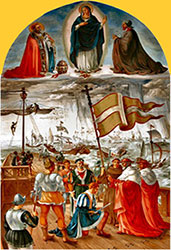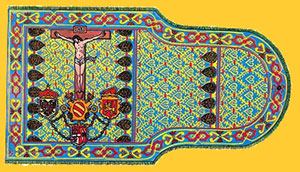A Rosary Concert,
with a Historical Twist
Marian Music of the
Battle of Lepanto
Last year, in honor of the 100th anniversary of the apparition of the Blessed Virgin Mary in Fatima in 1917, the Choir of the Priory of the Annunciation [Canons Regular of the New Jerusalem], presented their own Rosary Concert on October 21, 2017.
This year, Adam Taylor has created a brilliantly ingenius concert for October 7, 2018, the actual anniversary of the Battle of Lepanto, which led to the feast day of Our Lady of Victory (October 7), whose title was later changed to Our Lady of the Rosary.
Details of that concert, given at Saint James Catholic Church (Charles Town WV) follow.
The naval battle of Lepanto gained by Don John of Austria over the Turkish fleet on the first Sunday of October in 1571 responded wonderfully to the procession made at Rome on that same day by the members of the Rosary confraternity.
Saint Pius V thereupon ordered that a commemoration of the Rosary should be made upon that day, and at the request of the Dominican Order, Gregory XIII in 1573 allowed this feast to be kept in all churches which possessed an altar dedicated to the Holy Rosary.
In 1671 the observance of this festival was extended by Clement X to the whole of Spain, and somewhat later Clement XI, after the important victory over the Turks gained by Prince Eugene on 5 August 1716 (the feast of Our Lady of the Snows) at Peterwardein in Hungary, commanded the feast of the Rosary to be celebrated by the universal Church.
from "Feast of the Holy Rosary" [The Catholic Encyclopedia, 1912]
 In addition to being the initial cause for the feast of Our Lady of the Rosary on October 7, the Battle of Lepanto has long been considered of vital importance for the Church and for the whole of Western society.
We can still draw much inspiration from it in our own times, when our faith is under attack from within as well as without.
The courageous faithful of Lepanto — not just those who fought at sea, but (more appropriately for most of us) those who vigorously prayed the Rosary at home — should be a model for us today.
In addition to being the initial cause for the feast of Our Lady of the Rosary on October 7, the Battle of Lepanto has long been considered of vital importance for the Church and for the whole of Western society.
We can still draw much inspiration from it in our own times, when our faith is under attack from within as well as without.
The courageous faithful of Lepanto — not just those who fought at sea, but (more appropriately for most of us) those who vigorously prayed the Rosary at home — should be a model for us today.
The Holy League of 1571 was composed of several sovereign states: the Papal States, Spain, the Republics of Venice and Genoa, the Grand Duchy of Tuscany, and the Duchies of Savoy, Urbino, and Parma.
 The flag to the right is the banner of the Holy League, the Battle Flag of Lepanto designed by Pope Saint Pius V — a Crucifix supported by the shields of the members of the Holy League of 1571:
King Philip of Spain, Saint Pius V, the Repulic of Venice, and Don Juan of Austria, all united by the Chain of the Rosary.
The pattern symbolizes the fleets of the Holy League in formation, and the woven border recalls the power of the Chain of the Most Holy Rosary of the Blessed Virgin Mary protecting all the ships and sailors.
[Description courtesy of Ordo Militaris.]
The flag to the right is the banner of the Holy League, the Battle Flag of Lepanto designed by Pope Saint Pius V — a Crucifix supported by the shields of the members of the Holy League of 1571:
King Philip of Spain, Saint Pius V, the Repulic of Venice, and Don Juan of Austria, all united by the Chain of the Rosary.
The pattern symbolizes the fleets of the Holy League in formation, and the woven border recalls the power of the Chain of the Most Holy Rosary of the Blessed Virgin Mary protecting all the ships and sailors.
[Description courtesy of Ordo Militaris.]
For this concert, we selected composers from each of those member states.
Not all were born or lived there; some worked there for a time, and some merely dedicated music to the rulers of these nations, hoping to secure their patronage.
At the very least, it is likely that this music of theirs in honor of Our Lady would have been heard in the churches of these states around 1571, possibly even by the faithful who prayed and fought at Lepanto.
The concert was structured in four parts:
- The first was a set of Marian antiphons used after Compline (Night Prayer), with quite familiar texts.
- The second was a set of Marian motets composed for liturgical use throughout the year.
These pieces were presented in the order that they would have been heard throughout the liturgical year, from the first major Marian feast of the year (Immaculate Conception) to the last (Assumption).
- The third part of the concert consisted of a setting of the Ordinary of the Mass based on the chants of Mass IX "Cum jubilo" from the Liber usualis, prescribed for Marian feasts.
- The fourth and final part comprised a beautiful prayer to Our Lady, so appropriate for the sad and tumultuous times in which we find ourselves; and a hopeful finale which reminds us, as Our Lady does, that we are under her loving protection, and that we need only trust in her Son and His promise that the gates of hell shall not prevail against Holy Church — no matter who our enemies may be.
Part I. Marian Antiphons
Alma Redemptoris Mater by Francesco Guerrero (1528-1599) [Spain]
translation: O Loving Mother of our Redeemer…
sung Advent through February 2
Ave Regina cælorum by Costanzo Porta (c.1529-1601) [Duchy of Urbino]
translation: Hail, Queen of Heaven…
sung February 3 through the Triduum
Regina cæli by Cipriano de Rore (c.1515-1565) [Duchy of Parma]
translation: Queen of Heaven, rejoice…
sung Easter through Pentecost
Salve Regina by Felice Anerio (1560-1614) [Papal States]
translation: Hail, holy Queen…
sung Trinity Sunday through Advent
Sub tuum præsidium by Simon Boyleau (fl.1544-1586) [Duchy of Savoy]
translation: We fly to thy patronage…
sung Pre-Tridentine and post-1962 throughout the year
Part II. Marian Feasts throughout the Year
Quam pulchri sunt by Giovanni Pierluigi da Palestrina (1526-1594) [Papal States]
translation: How beautiful are thy steps…
Motet for Immaculate Conception (December 8)
Sancta et immaculata by Andrea Gabrieli (1532/3-1585) [Republic of Venice]
translation: O holy and immaculate virginity…
Matins Responsory for Christmas (December 25) / also used for Marian feasts
Diffsa est gratia by Giovanni Maria Nanino (1543/4-1607) [Papal States]
translation: Grace flows from thy lips…
Mary, Mother of God (January 1) post-1962
Hodie beata virgo Maria by Luca Marenzio (1556-1599) [Papal States]
translation: Today the Blessed Virgin Mary…
Magnificat Antiphon for Candlemas (February 2) / Purification of the BVM / Presentation of the Lord post-1962
Optimam partem by Francesco Corteccia (1502-1571) [Grand Duchy of Tuscany]
translation: Mary has chosen the better part…
Communio for Assumption (August 15) pre-Tridentine/Tridentine, OT XVI, Year C post-1962
Part III. Mass Setting
Missa de Beata Virgine by Cristóbal de Morales (1500-1553) [Spain, Republic of Genoa]
Part IV. Prayer and Finale
Sancta maria, succurre miseris by Tomás Luis de Victoria (c.1548-1611) [Spain]
translation: Holy Mother, aid the unfortunate…
Suffrage of the BVM pre-Tridentine; often associated with Our Lady of the Snows (August 5)
Ego flos campi by Alonso Lobo (1555-1617) [Spain]
translation: I am the rose of Sharon…
Canticle of Canticles 2:1-2
The Choir of the Priory of the Annunciation of the Blessed Virgin Mary (Charles Town WV):
- Christine Smitha, soprano
- Phoebe Wing, soprano
- Amy Kline, alto
- Adam Taylor, countertenor
- Paul English, tenor
- Anthony Smitha, bass
Oremus pro invicem! (Let us pray for one another!)
Concert given 07 October 2018
| 

